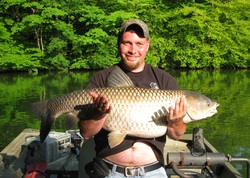 I have to do what?!? “To get your lake into shape you have to remove thousands of under 12 inch largemouth bass, remove every grass carp, catfish and striper (yellow bass) you can, fertilize the lake each spring to create a bloom, reestablish baitfish in the lake and create acres of fish structure”, my lake consultant calmly stated while handing me the bill for evaluating my lake. Man, what did I get myself into?!? Actually, it was exactly what I wanted. I had dreamed for decades about having a lake to care for, improve and maintain. And boy, this lake needed me! My wife and I purchased this beautiful 110 acre lake surrounded by woods just outside of Dyersburg, TN back in 2004. It was the realization of a dream. But now, just a few months after realizing the dream, it was meeting with reality. “Are there any other options?” I begged. “Yes, you could kill all the fish in the lake and start over. However, you would still have to add acres of fish structure.” he said. Why was all this necessary? My dream for the property extended way beyond maintaining the lake. I wanted to maintain and improve the property as a private natural park. But not just for my wife, children and me, but for later generations. I dreamed of it becoming financially independent through developing multiple income sources that wouldn't compromise the private park like setting through development or overuse. One already established income source was the fishing club on the lake. The previous owner started the club in the early 80's, just a few years after the lake was completed. Like most newly created lakes, the stocked fish quickly grew in size and expanded their population. For years the fishing was incredible with huge bass (up to 10 pounds), abundant bream (sometimes up to 2 pounds) and a growing population of clandestinely stocked white crappie (the crappie were seeded secretly by a fishing club member with the aid of a friend with an airplane). The fisherman were happy and so was the previous owner. Over 25 years later, the lake was showing signs of age. Like most man made impoundments, Fyrne Lake (formally known as Viar Lake) had been taken over by thousands of small bass. Largemouth bass are prolific breeders and eaters. They will eat any living thing that can fit in their oversized mouth. Depending upon their size, a female bass will lay between 2000 and 40,000 eggs! This invasion of hungry mouths began consuming everything in sight, including other bass. The existing fishing club members were frustrated by the small bass that kept taking their line, making it difficult to catch the bream, shell cracker (redear), crappie or the larger bass they sought. They shared stories and pictures of the way things used to be. I wanted to help, not only to keep the fisherman happy. I also loved to fish and I wanted Fyrne Lake to be the best it could be! But, I knew nothing about how to do it! Honestly, that was part of the appeal. I enjoyed learning, especially if it was going to help me conquer a new challenge. I just didn’t realize how much of a challenge it was going to be to turn things around! 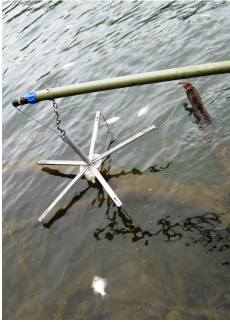 I started my research by scanning the internet, subscribing to a magazine called Pond Boss and located a lake consultant to provide a professional evaluation. I quickly began accumulating a library of information on lake management and it lead me to the realization of how many variables there were to achieve the quality of fishing I envisioned. I was hoping the lake consultant could help me formulate a long-term strategy. Luckily, it wasn’t long before he rolled up to the farm with his shock boat in tow. A shock boat comes equipped with a customized generator, transformer box and electrodes to suspend in front of the boat on one or two poles. Through adjusting the voltage, amperage and cycle frequency on the transformer box, a shock boat can gently stun fish, bringing them to the surface. The goal is to net, identify and measure the fish before they wake up and rush away. They don’t like being shocked any more than I enjoyed touching the electric fence as a kid on my grandmother Fyrne’s farm. However, just like my experience with her fence, the fish quickly recover without any negative long-term effect. The trip on the lake with the consultant turned out to be an amazing adventure! As we left the landing he fired up the generator and adjusted the dials on his transformer box. He shared how every lake is different and requires different settings to effectively bring up the fish. Variables like water conductivity, PH and temperature effect how deep the adjustable electrical field penetrates. Also, various fish species respond differently to the electrical settings. Experience and experimentation are necessary to “dial in” the proper output to bring up fish. Fortunately, my lake consultant was very experienced and it wasn’t long before we were seeing multiple fish floating to the surface. This was a fisherman’s dream! Fish were popping up all around us! I wanted one of these! We began netting the fish and bringing them into the boat for evaluation. Most of the bream were huge, but the bass were small and skinny looking. We released all the bream, but placed the smaller bass in an aerated tub to be weighed and measured when we returned to the landing. A key indicator of the health of the lake was going to be found through analyzing the condition of the bass population (more on that later). It was interesting to watch the consultant guide his boat along the shoreline seeking out structure to shock just as a fisherman would target the same area with a lure. Like clockwork, a promising looking structure would yield fish. Most continued to be bream and small bass with the occasional striper (yellow bass). However, we did shock up several large healthy looking bass and one huge blue catfish. Every large bass we weighed, measured and tagged on the spot then gently released them back into the lake. The catfish was another story. We kept him! As the day went on, the consultant observed that he hadn’t seen ANY aquatic plants and except for a few fallen trees along the shoreline and rotting stumps in the shallow end, the lake was devoid of structure. On a positive note, he added that the bottom contours were interesting. His depth finder was revealing numerous underwater ridges running out from shore with steep drop offs of up to 30 feet. However, even with the bottom contours, there wasn’t near enough structure for a lake our size. The reason for the absence of aquatic plants was soon revealed! As we approached the shallows at the top of the lake the water came alive! The combination of our presence and the electrical field around the boat had disturbed a school of grass carp. They were huge! Luckily, we were able to creep close enough to stun one. As the behemoth rolled up to the surface, the consultant’s assistant slipped a net over his head. The net barely stretched past his gill plates! Now it was my turn. I took my net and tried getting it around the grass carp’s tail. As I bumped it the fish came to and darted forward driving deeper into the net around its head almost ripping it from the assistant’s hands! Desperately, I forced my net around the thrashing tail and the two of us heaved the fish aboard. He seemed even larger in the boat! It was all I could do to lift him up with the scale to reveal a weight of 44 pounds! And this was just one of who knows how many grass carp in the lake. These grass carp don’t jump like the Asian carp that have invaded the Mississippi and its tributaries. They’re also sterile and are often used in lakes to help control aquatic vegetation. It turns out the previous owner had intentionally stocked these grass carp in the lake to take care of a weed problem… problem was he stocked too many… about a thousand too many! And these fish were keeping every sprout of aquatic vegetation that reared its head consumed. They had even “hedged” the overhanging tree branches of any leaves they could reach from the lake’s surface. (I later received reports of fisherman in the fall seeing these monsters waiting under oak and persimmon trees to catch the acorns and fruit as they fell!) Man! This lake had issues! But wait, there’s more! The lake consultant had not seen ONE single baitfish in the lake! With a knowing look on his face, he turned the boat back toward the landing. Even though he knew what the results would be, he and his assistant meticulously weighed and measured each of the hundred plus small bass in the tub. Using the chart included with this article, they compared the stats. ALL of the bass measured were underweight for their length. A healthy 12” largemouth bass should weight 14 ounces (see chart). Why did our 12” bass only weight 10 to 12 ounces? “Because they are starving!” was his answer. Largemouth bass had terribly overpopulated Fyrne Lake to the point where these fish had consumed all of the baitfish (that’s where they all went!) and were eating the majority of the small bream and crappie fry before they had a chance to mature… and they still didn’t have enough to eat! 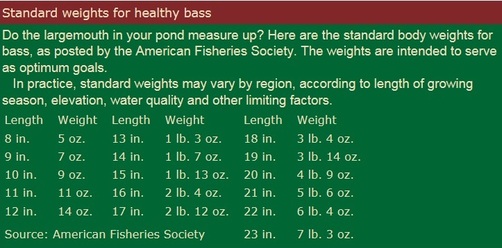 Reprinted with permission from Pond Boss Magazine Reprinted with permission from Pond Boss Magazine As the day went on, the consultant observed that he hadn’t seen ANY aquatic plants and except for a few fallen trees along the shoreline and rotting stumps in the shallow end, the lake was devoid of structure. On a positive note, he added that the bottom contours were interesting. His depth finder was revealing numerous underwater ridges running out from shore with steep drop offs of up to 30 feet. However, even with the bottom contours, there wasn’t near enough structure for a lake our size. The reason for the absence of aquatic plants was soon revealed! As we approached the shallows at the top of the lake the water came alive! The combination of our presence and the electrical field around the boat had disturbed a school of grass carp. They were huge! Luckily, we were able to creep close enough to stun one. As the behemoth rolled up to the surface, the consultant’s assistant slipped a net over his head. The net barely stretched past his gill plates! Now it was my turn. I took my net and tried getting it around the grass carp’s tail. As I bumped it the fish came to and darted forward driving deeper into the net around its head almost ripping it from the assistant’s hands! Desperately, I forced my net around the thrashing tail and the two of us heaved the fish aboard. He seemed even larger in the boat! It was all I could do to lift him up with the scale to reveal a weight of 44 pounds! And this was just one of who knows how many grass carp in the lake. These grass carp don’t jump like the Asian carp that have invaded the Mississippi and its tributaries. They’re also sterile and are often used in lakes to help control aquatic vegetation. It turns out the previous owner had intentionally stocked these grass carp in the lake to take care of a weed problem… problem was he stocked too many… about a thousand too many! And these fish were keeping every sprout of aquatic vegetation that reared its head consumed. They had even “hedged” the overhanging tree branches of any leaves they could reach from the lake’s surface. (I later received reports of fisherman in the fall seeing these monsters waiting under oak and persimmon trees to catch the acorns and fruit as they fell!) Man! This lake had issues! But wait, there’s more! The lake consultant had not seen ONE single baitfish in the lake! With a knowing look on his face, he turned the boat back toward the landing. Even though he knew what the results would be, he and his assistant meticulously weighed and measured each of the hundred plus small bass in the tub. Using the chart included with this article, they compared the stats. ALL of the bass measured were underweight for their length. A healthy 12” largemouth bass should weight 14 ounces (see chart). Why did our 12” bass only weight 10 to 12 ounces? “Because they are starving!” was his answer. Largemouth bass had terribly overpopulated Fyrne Lake to the point where these fish had consumed all of the baitfish (that’s where they all went!) and were eating the majority of the small bream and crappie fry before they had a chance to mature… and they still didn't have enough to eat! 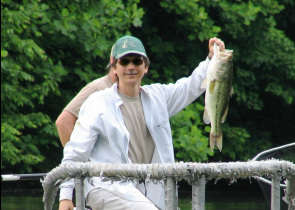 Any body of water had a set number of pounds of predator fish it can support depending upon fertility with all other factors remaining constant. What that means is if your lake can support 10,000 pounds of predator fish, your make up could be 1,000 ten pound fish, 10,000 one pound fish or some combination in between. Reducing the number of predator mouths will concentrate the food source in the remaining fish to make them larger. We had so many largemouth bass mouths to feed most of ours were not even reaching a pound! He explained how controlling the bass overpopulation was necessary to accomplish any improvement in the fishing. But, that was just the first component of what was needed. The lake was supporting only a fraction of the fish population possible because of limited habitat and food sources. Between the grass carp consuming all of the natural aquatic plant cover and the limited structure (fallen trees, stumps, brush, etc.) present in the lake, the fish had few places to hide long enough from predators to mature. The food chain had also been disrupted by the bass consuming every last baitfish. We needed to reestablish baitfish in the lake while also providing cover for them to hide in and reproduce. Fertilizing the lake to create a controlled plankton bloom in the late spring would provide an ample food source for the baitfish pumping up the number of pounds of predator fish the lake could support. However, we needed to be cautious. Over fertilization can cause a fish kill. To bring Fyrne Lake up to where it needed to be, I had some decisions to make. (Next article: Our Lake Management Plan) |
AuthorKevin Griffith Archives
September 2018
Categories |
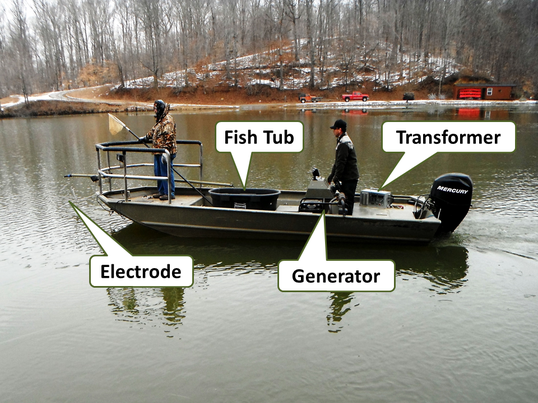
 RSS Feed
RSS Feed